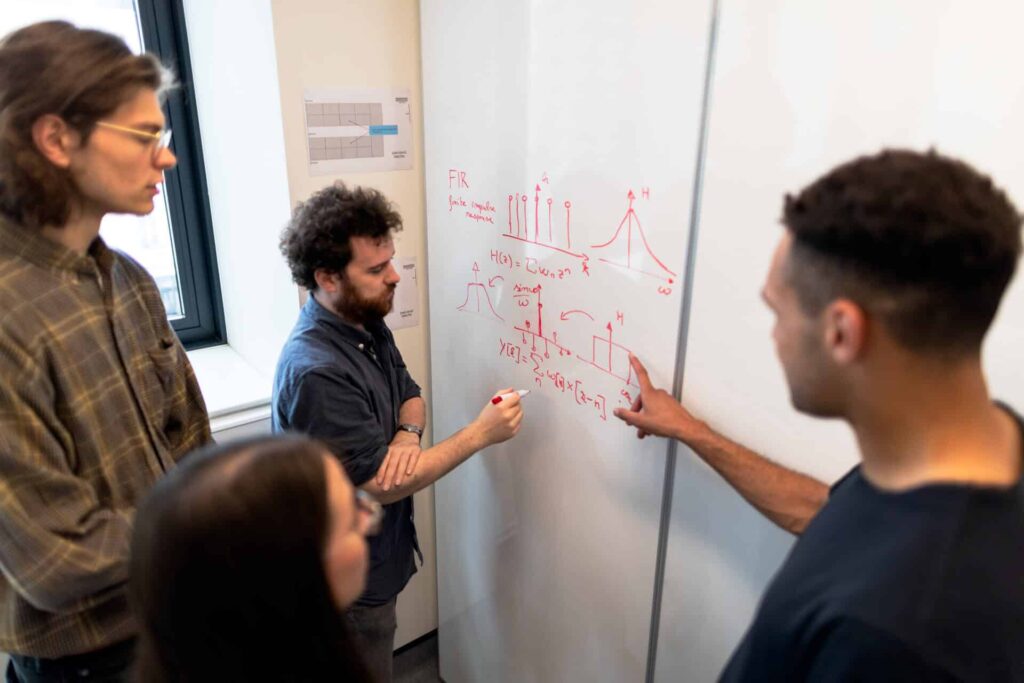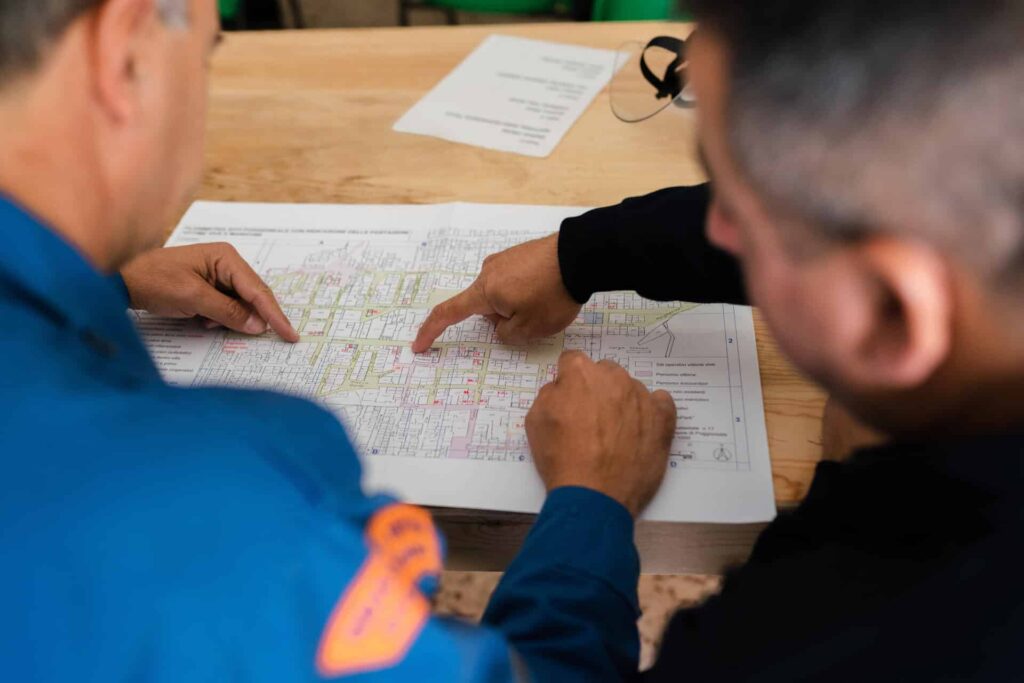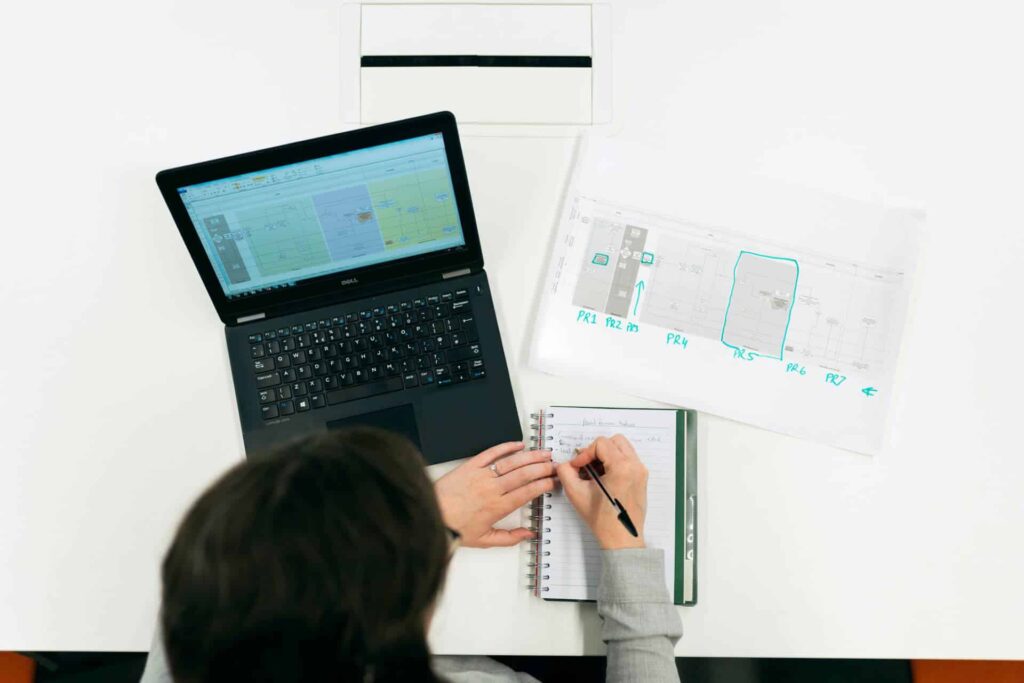Innovation in the workplace: 5 Ways to boost productivity and engagement

Innovation in the workplace requires both highly productive workspaces and high employee engagement.
The workplace is rapidly changing, becoming increasingly hybrid and remote. To spark innovation, companies and facility managers (FMs) therefore need to create a culture of innovation that caters to every employee regardless of location or work schedule.
In the following article, we will explore 5 key ways organizations can boost innovation in the workplace, remembering that employee needs and satisfaction should always remain the top priority.
Why is innovation important in the workplace?
‘Innovation’ is a word that often gets used without really understanding what it is and why it’s so important for the workplace.
Writing in the Harvard Business Review, leading strategy and innovation expert Vijay Govindarajan says, “(c)reativity is about coming up with the big idea. Innovation is about executing the idea — converting the idea into a successful business.”
In other words, creativity, also important to success, is about coming up with the lightbulb, while innovation is about discovering new and better ways to make the lightbulb and get it to market. As such, compared to creativity, innovation comes more from good teamwork and problem-solving systems. And it can be fostered—or hindered—by an organization.
Innovation is important in the workplace. It can make organizations more competitive, improve existing processes, and help attract and keep top talent. Innovative workplaces are also efficient ones, which can ultimately lead to cost savings as well.

How to implement innovation in the workplace
Innovation in the workplace doesn’t happen overnight, and it doesn’t happen without deliberate strategies put in place to support employees.
This is especially true given the influx of hybrid work, where the workplace is now as likely to be an employee’s kitchen table as it is a shared office space. Employees now need to be able to access and participate in all aspects of a company culture, wherever they are, presenting new organizational challenges that must be overcome.
Implementing workplace innovation starts from the top down. Companies that want to maximize innovation need to provide all employees with the right climate and initiatives. To improve both innovation and creative thinking, employers therefore need to work hand-in-hand with FMs to design a workspace that is both supportive and collaborative for remote and in-office workers alike.
Ultimately, companies looking to foster more workplace innovation should focus on 5 key areas:
- Workplace strategies for innovation
- Work environments that stimulate innovation
- The importance of clear communication
- Software and tools to support workplace innovation
- Supporting workers to boost innovation
To boost innovation, FMs and organizations will need to ensure each of these areas is fully maximized. Let’s take a closer look at each.

1. Workplace strategies for innovation
We tend to think innovative ideas will occur organically, but the reality is that innovation requires a plan.
A company therefore needs to have a strategy in place to support and encourage innovation. This can include concrete actions like hackathons, innovation hubs, brainstorming sessions, and other team building activities. Companies should also create a plan to support employee health and wellbeing, while helping to increase employee collaboration and teamwork as well.
As we’ll explore further below, when developing a strategy for better innovation in the workplace, FMs may also experiment with different office layouts. It’s important to work to prevent silos from forming.
Organizations using any type of hybrid work model or fully remote work should also plan for regular hybrid meetings and use easily accessible, remote project collaboration tools. This can help replicate the often spontaneous collaboration and ‘eureka’ moments that traditionally happened around the metaphorical water cooler.

2. Work environments that stimulate innovation
Workplace design and organization can play a big role in how innovative employees can be.
Gone are the days of long commutes to traditional offices and 9-5 hours. Workers no longer have to stay stifled and siloed in cubicles. Employees are now demanding flexibility, and by offering options like flexible seating, desk booking, and room booking, employers can meet their demands in mutually beneficial ways.
Employers are now offering a range of work environments as well, depending on their company goals, all of which can lead to a more effective and inventive office.
The best work environment type will vary from organization to organization, but to encourage innovation, the following components are essential.
Hybrid is the future of work
Thrust into prominence because of the pandemic, there’s no doubt hybrid work is the future.
Hybrid workplaces blend both remote and in-office work in a variety of ways. This helps to ensure a safe return to the office, while creating a more flexible and innovative workforce going forward.
By following hybrid workplace best practices like giving employees greater visibility and using data to support employee working styles, FMs can tailor-make the best possible hybrid work environment for their company culture.
Effective space management
Ideally managed with robust space management software, effective space management helps FMs manage moves, accommodate new employees, and ultimately create a safe and dynamic workplace that encourages innovation.
Especially when FMs understand how employees are using their space on a daily basis, they can better manage it to create a vibrant, productive working environment.
Office neighborhoods increase collaboration
Office neighborhoods are an office layout strategy that organize team members into groups—i.e.: neighborhoods—based on shared characteristics like department, project, or even work style.
Organizations using office neighborhoods for in-office staff can expect increased productivity and collaboration. They should also expect to save space through providing more flexibility.
Given that 86% of employees and business leaders say a lack of collaboration is the top reason for workplace failures, practices like office neighborhoods that boost collaboration can be key to boosting innovation as well.
Activity-based working improves productivity
If office neighborhoods are the key to more collaboration, activity-based working (ABW) may be the key to more productivity, another key component of innovation.
Instead of being tethered to a desk, ABW lets employees work wherever they’ll be most productive at a given task. This could be in a coffee shop for focused work, an open space for collaborative work, or a conference room for group activities.
Assuming FMs have the software in place to easily accommodate ABW, this potential for more productivity and collaboration can help spur new innovative ideas and problem-solving.
Agile working
Similarly, agile working is a more extreme counterpart to ABW. It offers nearly unlimited flexibility to both in-office and remote workers. It lets them choose when, where, and how they can best complete their assigned tasks.
Agile working itself is an innovative new way of managing workers. Giving employees this level of respect and autonomy can help create a leading-edge business.
Flexible offices are innovative offices
Imagine if Bill Gates and Paul Allen hadn’t gone to the same high school. Or if Larry Page and Sergey Brin never found themselves working together on a research project during their time at Stanford.
The reality is that the best innovation often comes from collaboration and partnerships. This can be difficult to find and foster when workers are confined to the same desk, day in and day out.
It may seem simple, but offering flexible seating can have a profound effect on company culture and innovation. When employees move around an office to different bookable desks, they can be forced out of literal and figurative ruts.
Who knows what newness will happen when a product developer finds themself sitting next to the exuberant marketing specialist one day, and the shy accountant with lots of ideas the next.
And don’t be afraid: flexible offices aren’t just the realm of cutting-edge startups and venture capital entrepreneurs. Flexible seating can be easy for any organization to implement and manage. Especially when FMs have access to the right Integrated Workplace Management System (IWMS) tools.

3. The importance of clear communication
To promote innovation, companies and FMs must be clear with their expectations, while also noting that communication is a two-way street.
“Communication with employees is key in the new, flexible workplace,” says OfficeSpace CEO David Cocchiara. “Companies need to make sure all employees are informed on how, what, when, and why.”
Companies that want to foster innovation should use an open-door/communication policy where employees can meet with cross-functional teams to generate new ideas.
As previously discussed, regular online meetings and offering bookable meeting rooms can also help increase communication and collaboration for workers who are often or primarily remote.

4. Software and tools to support workplace innovation
To create more innovation in the workplace, workers and FMs alike need high quality software and systems in place. They need to feel safe, supported, and able to do their best work.
This is typically done with an IWMS, which works best when it offers the following functionality.
Safety measures
It’s hard to innovate and do your best work when you don’t feel safe.
That’s why any FM looking to boost innovation should also be looking to provide safety measures for those concerned about returning to the post-pandemic workplace.
Safeguard and Distancing Planner are two such OfficeSpace solutions that can help create a safer working environment and simplify social distancing.
Bookable spaces
As we’ve covered, innovation flows from collaboration and productivity. Both are supported by new and flexible ways of working.
As such, companies looking to boost innovation would be wise to offer at least some forms of bookable spaces.
Office hoteling, reverse hoteling, and hot desking are the most common ways to let employees share desks. Especially when office hoteling best practices are followed, these strategies can meaningfully power a wide variety of work strategies.
Similarly, room booking brings this capability to all spaces in the office, including meeting and conference rooms.
Integrations
When you’re frustrated, you’re not innovating, and perhaps nothing is more frustrating than having to learn new, unwieldy software programs.
That’s why FMs should choose IWMS software that integrates with whatever software their team is already using.
For example, OfficeSpace integrates with Slack and Microsoft Teams. Its robust API and webhooks make it easy to build custom integrations.
Meeting your teams ‘where they are’ creates a much friendlier user experience. This way, employees can spend their valuable time working on what really matters.
Visibility
Visibility is critically important to fostering innovation in hybrid work environments.
When employees can see who is already in the office, they can know what they’ll be walking into on any given day. They can also ensure they’re coming in when they’ll be most productive.
According to Luke Anderson, OfficeSpace VP of Product and Strategy, this communication can help build a sense of community while also supporting the bottom line.
“Ultimately, we’ve found that the easier you make it for workplace leaders to help keep people connected, the more willing they will be to take those smaller, necessary steps towards a more flexible work environment,” he says.
This visibility can come from a visual directory that provides an easy-to-use interactive floor plan that shows who is in the office, and when. Ideally, this will connect to a mobile app, so that employees can access this information anywhere.

5. Supporting workers to boost innovation
Happy, supported employees are innovative employees. So employee satisfaction and retention should always be the top priority when trying to create more innovation.
Organizations can empower employees by offering flexibility and encouraging good work-life balance. And FMs can empower them by providing them streamlined tools they need to not only do their job, but to excel and think outside the box.
Ultimately, prioritizing employee engagement so that employees feel connected to their workplace is one of the best ways to create a more enthusiastic and involved workforce.
Benefits of change and innovation in the workplace
Companies that survive the test of time are companies that are able to change with it.
If the only thing constant in life is change, this is especially true in business. Workplaces that are able to ‘go with the flow’ and even do better because of it are those that succeed.
When managed properly, change and innovation in the workplace can make employees happier and companies stronger. This can lead to greater flexibility, greater efficiency, and greater success.
OfficeSpace offers a complete suite of tools to support change and innovation in the workplace. Reach out for a free demo.
Photos: Kvalifik, ThisisEngineering RAEng, Christin Hume, Mapbox



